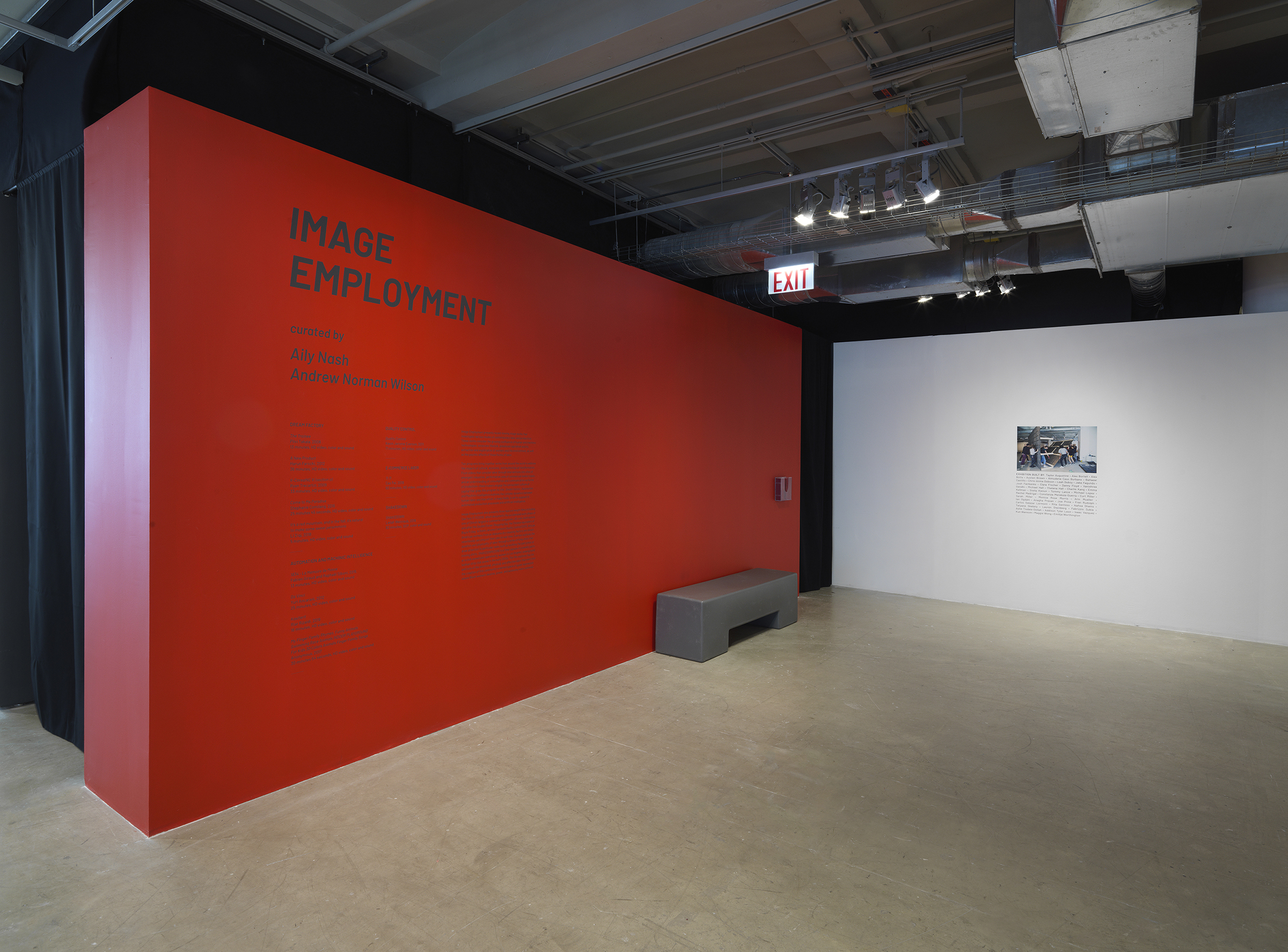
Curated by Aily Nash and Andrew Norman Wilson
Image Employment presents recent moving image works that investigate various modes of contemporary labor and production. These works consider the growing confluence of human and machinic technologies, corporate lifestyle, globalized capitalism and its extraction and exploitation of workers and the environment, as well as the psychic effects of these forms of labor.
Two programs bring together works from around the world to address the impacts of cultural, economic, and technological transformation. From videos that consider labor through interventions into sites of emergent industries, performative uses of commercial media tropes, and an understanding of consumption and communication as forms of production—these makers engage the omnipotent culture of capital that gives this program its title: Dream Factory. Automation and Machinic Intelligence explores the complex dynamics between human labor and that which, in many fields, is set to supplant it: automated production processes and artificial intelligence.
Image Employment also presents three feature-length films including Cao Fei’s 11:11, which documents the accelerated work phase of one of China’s largest e-commerce companies – JD.com—both before and after the Double Eleven Shopping Day, the Chinese equivalent of Black Friday. In Kevin Jerome Everson’s Quality Control, African-American workers from an Alabama dry-cleaning factory are shown relentlessly carrying out their jobs in real-time. Everson explores the duration and physicality of labor through a series of long shots that draw attention to particular tasks such as working the pant press or ironing shirts. SHAKEDOWN is a time capsule of a weekly party at a club owned and operated by women in Los Angeles’ underground lesbian strip club scene in the early 2000s. The film explores the ins and outs of the emotional, physical and affective labor that went into the creation of this community-oriented space of queer expression where black women’s desires, power, and autonomy were centered.
Screening Program:
Dream Factory
From videos that consider labor through interventions into sites of emergent industries, performative uses of commercial media tropes, and an understanding of consumption and communication as forms of production—these makers engage the omnipotent culture of capital that gives this program its title: Dream Factory.
Pilvi Takala’s The Trainee was produced in collaboration with a professional services firm, Deloitte, and Kiasma Museum of Contemporary Art in Finland. In order to realize the project, the artist was working for a month as trainee “Johanna Takala” in the marketing department of Deloitte, where only a few people knew the true nature of the project. During the month-long intervention, this marketing trainee starts to apply peculiar working methods which, in turn, calls into question systematic corporate work structures.
In Ryan Trecartin’s K-Corea INC. K, current temporal and spatial conditions of corporate involvement are scripted into an accelerated euphoria. The international characters in K-Corea INC. K, who perform different versions of what Trecartin calls “Koreas” (pronounced as “careers”), are white-collar workers in business-casual drag, white makeup, and blonde wigs, composing what the artist calls “work face.” Prosumer editing tools are pushed to their limits, spaces are collaged, Ikea sets are destroyed, and everything—from work positions, meeting points, relationships, identity, and meaning—are all temporary, disposable, and in-flux.
Harun Farocki’s video A New Product (2012) documents several internal meetings conducted by the Hamburg-based space-planning consultancy firm Quickborner Team (QT), which has advised some of the world’s largest multi-
nationals for over half a century. Networked communications allow employees to work anywhere—at home, abroad, from their smartphones, and of course, in the common corporate campus. Rather than focus on the laborer, as many documentaries concerned with industry and work tend to do, Farocki documents the corporate sector and the consultants who conceptualize its ever-shifting culture of work. Plunged into their internal brainstorming meetings, the viewer gets a sense of the jargon, energy, and personalities of otherwise nameless consultants.
Lumapit Sa Akin, Paraiso (Come to Me Paradise) is a science fiction documentary by Stephanie Comilang that uses the backdrop of Hong Kong and the various ways in which the Filipina migrant workers occupy the central urban spaces on their Sundays off. The film is narrated from the perspective of Paraiso, a ghost played by a drone who speaks of the isolation felt from being uprooted and living far from home. Paraiso’s reprieve comes when she is able to interact with the women and feel her purpose, which is to transmit their vlogs, photos, and messages back home. Raising questions around modern isolation, economic migration and the role of public space in both urban and digital forms, the video reflects on the ways in which technology is used as a vehicle for connection by these domestic workers, and a form of empowerment through the expression of their experiences.
It’s a red mountain, and in the fall, it’s natural to make some sweet persimmons is one video in a YouTube series by Li Ziqi, a Chinese food blogger and internet celebrity. She is known for creating food and handicraft preparation videos in her hometown of rural Mianyang, Sichuan, often from basic ingredients and tools using traditional Chinese techniques. As of 2019, she has over 5 million subscribers on YouTube, 16 million followers on Sina Weibo, and has inspired many bloggers to post similar content. This video follows Li Ziqi during a fall harvest, as she picks persimmons on a mountain side, peels them with her grandmother, and strings them up on a line to dry them. She then stores the dried persimmons in a wooden barrel and the video cuts to winter when she finds them crystallized with their own natural sugars. Li Ziqi’s videos document traditional food processing techniques, but also inspire a nostalgic life-style aesthetic that appeals to her international followers.
 The Trainee
The Trainee
Pilvi Takala, 2008, 13 min, HD Video, color and sound
 A New Product
A New Product
Harun Farocki, 2012, 36 min, HD video, color and sound
 K-CoreaINC.K (section a)
K-CoreaINC.K (section a)
Ryan Trecartin, 2009, 33 min, HD video, color and sound
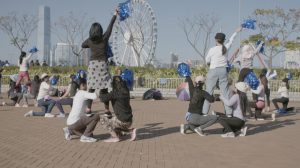 Come to me Paradise
Come to me Paradise
Stephanie Comilang, 2016, 25:45 min, HD video, color and sound
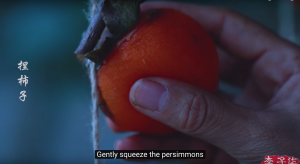 It’s a red mountain, and in the fall, it’s natural to make some sweet persimmons.
It’s a red mountain, and in the fall, it’s natural to make some sweet persimmons.
Li Ziqi, 2018, 5 min, HD video, color and sound
Automation & Machinic Intelligence
Automation and Machinic Intelligence
In 1801 in Lyon, France, Joseph Marie Jacquard (1752-1834) invented a loom that enabled unskilled workers to weave complex patterns in silk. The Jacquard Loom is controlled by a chain of multiple cards punched with holes that determine which cords of the fabric should be raised for each pass of the shuttle. The ability to store and automatically reproduce complex operations found widespread application in textile manufacturing, and is the conceptual precursor to the binary logic and programming that exists today in computing and automation technologies.
The central sequence in Fabien Giraud & Raphaël Siboni’s 1834 – La Mémoire de Masse unfurls amidst the Canuts revolts in Lyon in 1834, slotted between analogical imagery of technological reproduction, the delivery of a foal in a thoroughbred farm, and a Jacquard Loom at work. The Canuts revolts, now known as the ‘bloody week,’ erupted in response to the automation of labor in the silk industry by the Jacquard Loom and its use of an early form of digital data storage – the punched card. This event, within the history of 19th century worker’s rights movements, is actually the first revolt against modern computation. The animation software used by the artists to render the erupting crowd of protesters (also used in the film World War Z [2013], which likely depicts more zombies than the entire history of the genre) was programmed to visualize complexity by efficiently guiding artificial intelligence agents and pulling from vast databases of motion capture performances to employ a dynamic repertoire of bodily movement and interaction for bodies in rebellion mode. This riot simulation then operates a reversed history by transforming a revolt against the algorithm into an algorithm of revolt.
Forthcoming advancements in fields such as artificial intelligence and renewable energy have tin poised to be the most impacted mineral by technological development. Currently, one third of global tin extraction takes place on Bangka island in artist Riar Rizaldi’s home country of Indonesia. Natasha is a solar-powered A.I. voice, and in Rizaldi’s video Kasiterit, they trace their genealogy and the truth of their origin; from capital liquidity to labor dynamics. This feminized voice—familiar through its employment as a voice assistant by tech companies—narrates the emergence of tin mining on Bangka island and their existence from perspectives such as value theory, the philosophy of time, genetic mutation, geopolitics, and automation.
Yuri Ancarani’s da Vinci explores the complex relationship between surgeons and the da Vinci Robotic surgical system. The video follows the work routine of Dres Franca Melfi and Olivia Fanucchi performing robotic surgery at the University Hospital in Pisa, Italy. Ancarani arranges blue-tinted endoscopic images and scenes from the operation room, adding a low-pitched ambient soundscape of faint heartbeats. The surgery staff largely stand passive, monitoring screens and awaiting further instructions, as the whirring robot arms breeze about the patient’s body. The layers of computation between physician and patient calls into question our typical notion of authority and liability, and suggests future operating rooms in which just one human remains–the patient.
Funny Animals Swimming Race Animals INDOOR PLAYGROUND For Kids 3D Colors Animals Finger Family Songs is an anonymously produced video sourced from YouTube Kids. In 2017, the thinkpiece economy exposed the uncanny and often inappropriate corners of the channel, which is intended to curate and control content access for children twelve and under. The uproar was oriented around how YouTube’s algorithms, clickbait culture, and user-end profit incentives, have led to algorithmically generated content, which has mutated to involve surreal and disturbing themes. Many of these TV episode-length “cartoons” compile strings of actions that never cohere to a plot, instead only demonstrating the diminished narrative possibilities produced by artificial intelligence. Typically rendered with a modified Grand Theft Auto graphics engine, the animated Hollywood superheroes and stock animals plod through several vague scenarios, one after another: swimming, racing, fighting, always somehow filling time. Myriad YouTube channels recompiled these algorithmic constructs in thinly veiled permutations. Yet above the uncanny valley effects of this zombie content, there exists a perverse, human-selected range of motifs which have entered the autoplay cycles: The Joker drugging and abducting Elsa from Disney’s Frozen; Elsa getting spinal surgery; “surprise” videos which seem designed to traumatize, such as Peppa Pig getting a taste of bacon and cannibalizing her family, and eventually herself; and most predominantly, syringe injection, which serves as a symbolic vehicle for transformation, but also punishment (one title: “Crying Babies! Accident! Bad Baby Playing Doctor & Learn Colors With Injections! Finger Family Song”). The Reddit community dubbed this scandalous phenomenon “ElsaGate,” and major advertisers such as Adidas pulled funding from YouTube, finally forcing the company to address its long-standing failures of content moderation. In late November of 2017, YouTube purged much of this content, including entire channels, deleting billions of views, and some of their most popular, verified accounts.
Current discourses in the arts often treat AI as both unrepresentable and unable to create cultural content: intelligence is one thing, human consciousness is another. However, even if one is to situate aesthetic interpretation within human consciousness, an unintentional (read as: unprogrammed) self-criticism emerges from the infamous YouTube Kids videos. Their alienating, iterative formal qualities, resembling the reductive formalism of much early video art and structuralist film, visually manifest both the “script” of the AI’s labor and its execution while confusing the role of human labor in the process. While humans within the anonymous company devised the parameters of the videos, they can be thought of as recordings of an AI “playing” generative graphics software that can be run ad infinitum to produce a quantity of revenue generating content unwatchable by any individual human. Add to this that AI bots were employed to perform the labor of viewing, and generate more ad revenue through inflated view counts, and it becomes clear that the most sophisticated yet least understood forms of AI today are not robots performing manual labor, but rather those mystifying, invisible, unknowable applications of intelligence that replace or augment the human laborer without a trace.
 1834 – La Mémoire de Masse
1834 – La Mémoire de Masse
Fabien Giraud & Raphaël Siboni, 2015, 13 min, HD video, color and sound
 Da Vinci
Da Vinci
Yuri Ancarani, 2012, 25 min, HD video, color and sound
 Kasiterit
Kasiterit
Riar Rizaldi, 2019, 18min, HD video, color and sound.
 My Finger Family Rhymes, Funny Animals Swimming Race Animals INDOOR PLAYGROUND For Kids 3D Colors Animals Finger Family Songs
My Finger Family Rhymes, Funny Animals Swimming Race Animals INDOOR PLAYGROUND For Kids 3D Colors Animals Finger Family Songs
Anonymous, 2017, 30 min 54 seconds, HD video, color and sound
Quality Control
In Kevin Jerome Everson’s Quality Control, African-American workers from an Alabama dry-cleaning factory are shown relentlessly carrying out their jobs in real time. Composed of a series of long takes, a handful of short silent montages, and an interview sequence, Everson explores the physicality of labor through an attention to particular tasks such as operating the pant press or ironing shirts. With an emphasis on duration and the resulting rhythms of repetition, in the opening shot of the film Everson frames a man at his station as he receives the shirts and blazers that float toward him like ghosts and wraps them around an off-white dress form. Later we see a woman working a pant press, laying down each leg, and using a hand-iron to flatten whatever wrinkles were missed. Significantly, the work draws out the collaborative process between human workers and machines, pointing to the persistent need for laborers despite the global trend towards increasingly mechanized and automated processes within factories. Although the socio-economic and racial make up of the workers is apparent, it is never explicitly discussed and not the primary focus of the work; in the same way Everson’s practice is dedicated to the formal considerations which allow for the complexity of his subjects to dominate the screen.
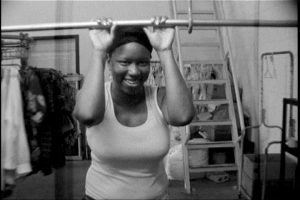 Quality Control
Quality Control
Kevin Jerome Everson, 2011, 71min, HD video, color and sound
Image: © Kevin Jerome Everson; courtesy the artist; Trilobite-Arts DAC; Picture Palace Pictures
E-Commerce Labor
Cao Fei’s 11:11 documents the accelerated work phase of one of China’s largest e-commerce companies – JD.com – both before and after the Double Eleven Shopping Day, the Chinese equivalent of Black Friday. From the processing of merchandise at JD.com’s enormous distribution center on the outskirts of Beijing and the Double Eleven national command center at JD.com’s headquarters, to the thousands of delivery points spread across the city’s commercial and residential districts, unskilled workers on 16 hour shifts are depicted amidst drones, driverless vehicles, and other automation technologies that threaten to replace their labor.
11:11 was made in conjunction with Cao Fei’s Asia One, a science fiction-documentary hybrid filmed in a fully automated JD.com warehouse in Shanghai. The video tells the story of the factory’s two remaining employees and their robotic assistant FIG. 1, who are observed through the warehouse surveillance system. The counterpoint that 11:11 conveys is that the final steps of this logistics chain are still more reliant on humans than one would expect. While a fully automated future may not be far off, a significant amount of the heavy lifting and arduous tasks remain. And in the case of the labor force depicted in 11:11, over ninety percent of the workers have migrated from elsewhere in China and often live amongst several generations in one-room apartments.
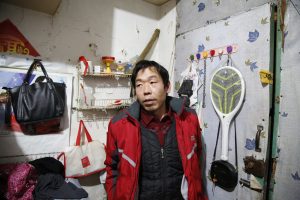 11:11
11:11
Cao Fei, 2018, 60 min, HD video, color and sound
SHAKEDOWN
Leilah Weinraub’s SHAKEDOWN is an intimate time capsule of a weekly party at a club owned and operated by women in Los Angeles’ underground lesbian strip club scene in the early 2000s. The film explores the ins and outs of the emotional, physical and affective labor that went into the creation of this community-oriented space of queer expression where black women’s desires, power, and autonomy were centered. It highlights the possibility for an alternative economy, one that remained all black, all female, and operated entirely through cash. Weinraub, a participant and member of this community, began documenting the party’s events, backstage banter, and unforgettable performances when she started attending in her early twenties. The film combines Weinraub’s footage with archival material and party posters, and includes up-close portrayals of several of the key figures, including creator and emcee Ronnie-Ron, star dancers Egypt and Jazmine, and the mother of the scene, Mahogany. SHAKEDOWN shares the unique cultural expressions of this community, which have often been appropriated by mass culture, yet are rarely seen and shown on their own terms.
 Shakedown
Shakedown
Leilah Weinraub, 2018, 82 min, DCP, color and sound
Gallery Screening Schedule:
11:05 a.m. – Cao Fei, 11:11
12:05 p.m. – Pilvi Takala, The Trainee
12:20 p.m. – Harun Farocki, A New Product
12:55 p.m. – Ryan Trecartin, K-CorealNC.K (section a)
1:30 p.m. – Stephanie Comilang, Come to me Paradise
2:00 p.m. – Li Ziqi, It’s a red mountain, and in the fall, it’s natural to make some sweet persimmons.
2:05 p.m. – Kevin Jerome Everson, Quality Control
3:15 p.m. – Fabien Giraud & Raphaël Siboni, La Mémoire de Masse
3:30 p.m. – Yuri Ancarani, Da Vinci
3:55 p.m. – Riar Rizaldi, Kasiterit
4:10 p.m. – Anonymous, My Finger Family Rhymes, Funny Animals Swimming Race Animals INDOOR PLAYGROUND For Kids 3D Colors Animals Finger Family Songs
4:40 p.m. – Leilah Weinraub, SHAKEDOWN
Related Programs:
THURSDAY, NOVEMBER 21, 2019 | 6:00 PM
Conversations At The Edge
Gene Siskel Film Center
164 North State Street
Image Employment – Aily Nash
2012–2019, United States/United Kingdom/Hong Kong/Canada/Italy/Germany, multiple formats, ca. 75 min followed by discussion
Aily Nash is a curator based in New York. She is co-curator of the Projections section of the New York Film Festival, and program advisor to the International Film Festival Rotterdam’s Short Film section. She served as a Biennial advisor and co-curator of the film program for the 2017 Whitney Biennial, and was Head of Programming for the 2018 edition of the Images Festival in Toronto. She has curated programs and exhibitions for MoMA PS1 (New York), Brooklyn Academy of Music (New York), Anthology Film Archives (New York), Institute of Contemporary Art (London), Kiasma Museum of Contemporary Art (Helsinki), Tabakalera Centre for Contemporary Culture (San Sebastian), FACT (Liverpool), Image Forum (Tokyo), Ghost:2561 (Bangkok) and others. She curated five seasons of the Basilica Screenings series at Basilica Hudson (2012-2016). In 2015, she was awarded a Curatorial Fellowship from the Andy Warhol Foundation. In 2018, she commissioned new works by artists James N. Kienitz Wilkins and Lucy Raven through the Finnish Cultural Institute New York’s MOBIUS Curatorial Fellowship in partnership with PUBLICS and Heureka, Finnish Science Center.
Andrew Norman Wilson is an artist based in Los Angeles. Solo exhibitions include the Kunstverein Braunschweig (2019), the Fotomuseum Winterthur (2019), Center for Contemporary Art Futura (2018), and the Broad Art Museum in Michigan (2017). Recent group exhibitions include Picture Industry at Luma Arles (2018), Techne and the Decency of Means at the Künstlerhaus Stuttgart (2017), Dreamlands at the Whitney Museum of American Art (2017), the Gwangju Biennial (2016), the Berlin Biennial (2016), Bread and Roses at the Museum of Modern Art Warsaw (2016), and On Sweat, Paper and Porcelain at CCS Bard in Annandale-on-Hudson, New York (2015). He has lectured at Oxford University, Cambridge University, Harvard University, Yale University, and UCLA, where he is now visiting faculty. His work has been featured in Aperture, Art in America, Artforum, ArtReview, BOMB, Camera Austria, Frieze, The New Yorker, and Wired. He has published writing in Artforum, e-flux, DIS, and a Darren Bader monograph from Koenig Books. He has curated programs and exhibitions for MoMA PS1, FACT Liverpool, Kunstlerhaus Stuttgart, e-flux, and more.